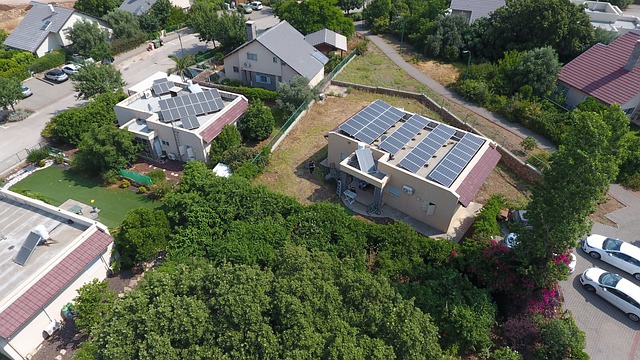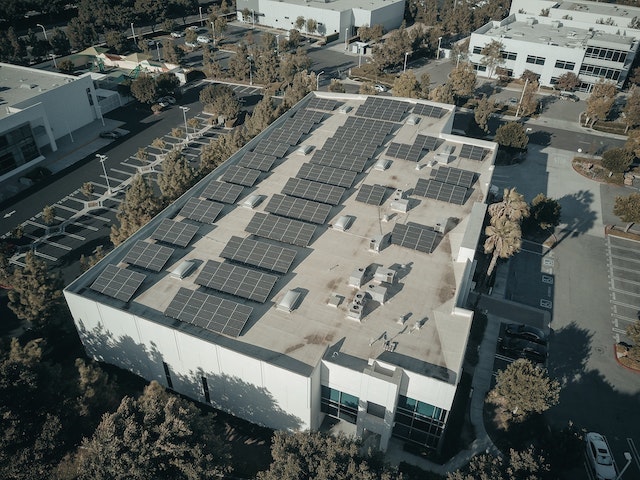Table of Contents
ToggleSolar photovoltaic (PV) energy produces zero direct pollution or greenhouse gas emissions. Thus, it’s arguably the most promising renewable energy resource.
Furthermore, solar is a great energy option for homes and buildings with disparate roof configurations. Despite what many often see or believe, solar panels on flat roofs are more common than we’d like to think. A flat roof is no different from a flat ground, and solar farms worldwide are built on flat ground.


Can I put solar panels on a flat roof?
Yes, solar panels can be easily installed on a flat roof. Flat roofs are often a good choice for solar panel installation because they provide a large, unobstructed area for the panels to be installed.
There are several different methods of installing solar panels on a flat roof. However, the options differ based on the roof’s unique characteristics and the types of solar panels utilised.
For example, solar panels can be installed using roof mounts, specially designed brackets that attach the panels to the roof. They can also be fixed on a roof with a weighted mounting system, preventing the roof from being damaged.
In some cases, it might also be possible to integrate the solar panels into the roof, creating a built-in look for the solar installation.
How to install solar panels on a flat roof?
One can lay the panels down on a flat roof as they would on a pitched roof. However, this limits the absorption of sunlight. That’s why a tilted mounting system is usually recommended.
To solar panels on a flat roof, follow these steps:
- Select the best location for your solar panels. It’s typically the location that receives the most direct sunlight, and the optimum angle is about 30 degrees.
- The roof must be cleaned to remove all dirt, debris, and moisture that could affect the installation process.
- Then estimate and draw a line on the roof with a pencil or chalk to mark the exact location of the solar panels.
- Install the tilted mounting system. This commonly involves attaching metal brackets to the roof with screws or bolts.
- Ensure panels face the south at an optimal angle for energy production. This will maximize renewable energy production for the homeowner.
- Install and secure the panels to the mounting system with bolts or other fasteners.
- The solar panels are connected to an inverter, which enables AC electricity generated from them.
- You’ll need to install a monitoring system to ensure the solar panels are working properly.
Also read: Solar Panel Installation Guide.
Benefits of installing solar panels on a flat roof
The benefits of installing panels on a flat roof include the following:
- Offers a green, clean, renewable energy source for your home.
- The angle of the panel is more flexible. This enables the panel to sit at an angle to capture the maximum amount of solar energy while remaining self-cleaning in the rain.
- The installation and maintenance of solar panels on flat roofs are easy, as flat roofs offer plenty of access space.
- Flat roofs are usually less visible and seldom seen from the road. Solar PV panels are typically installed onto them more discreetly.
- Flat roofs can take a larger range of solar panel types.
Disadvantages of installing solar panels on a flat roof
Disadvantages that should be considered before installing solar panels on a flat roof include the following:
- Photovoltaic systems on flat roofs consume more space per kW than on pitched roofs. This is because there must be a defined separation between rows of the PV panels to prevent on-row shading.
- Flat roofs are more vulnerable to leaks and other damage, so the solar panels and mounting system must be installed carefully to prevent water from entering the building.
- Unlike pitched roofs, flat roofs may not receive as much direct sunlight.
- Solar panels installed on flat roofs get much dirtier over time. In turn, this dirt reduces energy production. Nonetheless, this can be avoided with regular cleaning.
- The weight of the solar panels and mounting system can put additional strain on a flat roof, which may require reinforcement to support the extra weight.
Flat roof solar panels considerations
Here are a few aspects you may need to consider before starting with the installation:
Installed at a pitch
To capture maximum sunlight and keep panels clean, they should be mounted at least at a 10-degree angle pitch. Fortunately, self-standing solar panels are usually installed at a 20 and 50-degree angle.
Wind impact
Flat-roof solar systems can be at risk of being damaged by high winds. The panels are either bolted to the roof or weighted down to prevent this. In addition, a support structure and bracket are typically attached to the roof to support and secure it.
If a greater degree of security is desired, the panels are connected to the roof using this method. Weighting down the system is much simpler. It requires installing ballast frames and heavy slabs on the roof before mounting the solar panels.
Impact on roof warranty
It is crucial to check your roof’s warranty before installing a free-standing solar system. Normally, a ballasted solar system is compatible with a flat roof’s warranty. However, if the solar system is set to the roof, it could impact the roof’s warranty.
Therefore, before installing a free-standing solar system, you must review the condition of your roof and overall system.
Planning permission
When it comes to solar panel installation, planning permission is seldom required. However, we recommend contacting your local planning authority before going solar if you live in a conservation area or listed building.
The condition of the roof
Before installing any solar panel on a flat roof, it’s crucial to ensure that the roof is in good condition and can handle the weight of the panels. Old or damaged roofs may require additional reinforcement before installation.
The cost and potential return on investment
Installing solar panels can be a significant investment, so it’s important to carefully consider the cost and potential return on investment. Research different solar panel brands and compare prices to find the most cost-effective option.
Additionally, consider government incentives and utility rates to determine the potential savings and payback period.
What’s the optimum angle for flat roof solar panels?
For solar panels to be effective, they need to be orientated to receive direct sunlight for most of the day. If your flat roof is not oriented towards the south (in the Northern Hemisphere) or the north (in the Southern Hemisphere), it may not be the best position for solar panels.


Solar panels should be mounted at a pitch at least 10 degrees angled to catch as much sunlight as possible. Fortunately, self-standing solar panels are usually installed at a 20 and 50-degree angle.
Cost of installing solar panels on a flat roof
Installing solar panels on a flat roof usually costs about 20% more than on a pitched roof. However, costs vary depending on several factors, including the number of panels and mounting technique used.
The main reason flat roof solar panel installations are more expensive is the additional cost of materials for the framing system and ballast weight. You’ll also usually need to hire a structural engineer, which adds to the cost.
Other tips to install solar panels on a flat roof
Here are some other useful tips to keep in mind if you’re considering solar panels for a flat roof:
- For countries that give solar incentives and rebates, they should still be available regardless of whether the panels are installed on a flat roof or a pitched roof.
- Regarding the highest possible energy production, you should always use traditionally mounted solar panels rather than solar shingles on your flat roof. You can install solar shingles on your flat roof, but they likely won’t be very efficient unless you angle them.
- Your flat-roof solar system should produce as much energy as a solar system installed on a roof with a conventional slope. This is because flat roofs often enable the perfect angle to be chosen. Thus, system design and installation can be more flexible and efficient.
Also, read our article on “Rooftop Solar Panels.”
Conclusion
In conclusion, you can install a solar panel on a flat roof. However, there are several things to consider before doing so, such as the direction and angle of the roof, roof condition, the potential for shading, and the availability of a power source.
It’s also important to consider the cost and potential return on investment. So if you decide to install a solar panel on your flat roof, it’s recommended that you consult with a professional solar installer to ensure that the panels are installed properly and in a way that maximises their effectiveness.
For more on solar, head to Justsolar.com.





